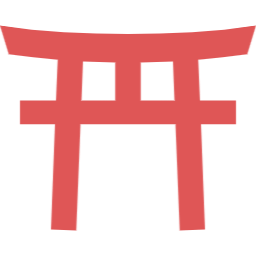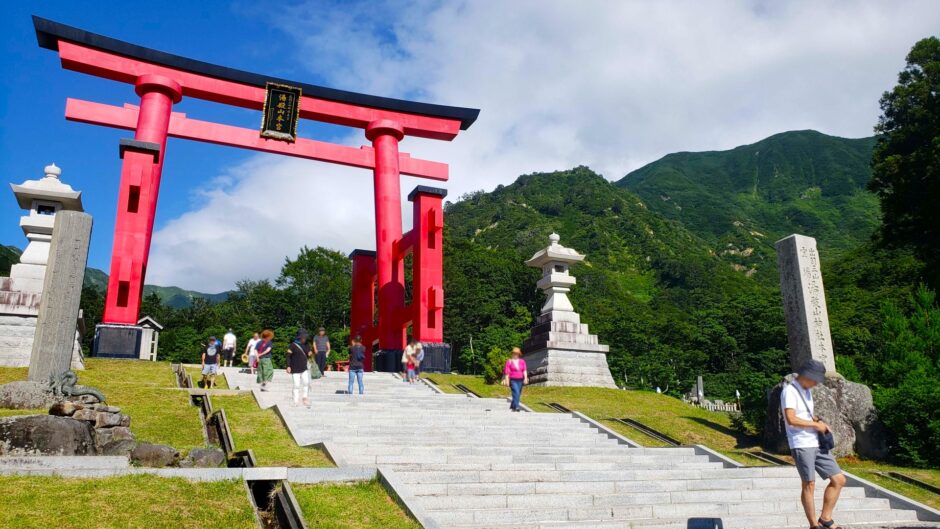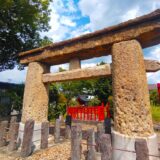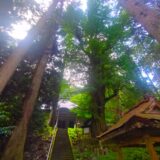【Yudonosan Shrine Summary】
Yudono-san Shrine is believed to have been founded around 593. It is said that over 1,400 years ago, when Prince Hachiko, the founder of Dewa Sanzan and son of the 32nd Emperor Sujun, unified and opened the Dewa Sanzan mountains, Yudono-san was also opened. A major characteristic distinguishing it from other shrines is the absence of a main hall or shrine buildings. This stems from the belief that the mountain itself is a divine dwelling place, prohibiting the creation of artificial sites of worship. Since ancient times, it has served as a center for mountain worship, particularly Shugendo practices. During the Edo period, it gained popularity among commoners as a “journey of rebirth” traversing the present, past, and future. Even today, it attracts numerous Shugendo practitioners and pilgrims.
The enshrined deities are Ōyamatsumi-no-Kami, Ōkuninushi-no-Mikoto, and Sukunabikona-no-Kami.
【Yudonosan Shrine Great Torii】
![Yudonosan Shrine【Yamagata] DSC 2086 1024x768 - Yudonosan Shrine【Yamagata]](https://japan-shrine.info/wp-content/uploads/DSC_2086-1024x768.jpg)
It’s located right near the parking lot, so you can go see it immediately. Standing 18 meters tall, it was constructed in 1993 (Heisei 5).
![Yudonosan Shrine【Yamagata] DSC 2092 1024x768 - Yudonosan Shrine【Yamagata]](https://japan-shrine.info/wp-content/uploads/DSC_2092-1024x768.jpg)
The torii gate is of the Ryōbu-tori style, commonly seen at Shinto shrines that incorporated Buddhist elements. While its height is comparable to the large torii at Kitaguchi Hongū Fuji Sengen Shrine, the sheer sky as its backdrop lends it tremendous presence. I believe the Yudono Shrine Great Torii ranks around 18th largest in Japan. It’s roughly half the size of the Ōharai Great Torii in Wakayama Prefecture.
【Yudonosan Shrine Tamahime Inari Shrine】
Pass through the large torii gate, and you’ll find the entrance to Tamahime Inari Shrine on your right.
![Yudonosan Shrine【Yamagata] DSC 2094 1024x768 - Yudonosan Shrine【Yamagata]](https://japan-shrine.info/wp-content/uploads/DSC_2094-1024x768.jpg)
The date of its founding is unknown, but it appears to have been venerated since ancient times, using a stone pillar as its sacred object. Through donations from believers, the shrine’s sacred tree, shrine hall, and torii gate were constructed in 1986 (Showa 61). The enshrined deity is Ugahimitama-no-Mikoto.
![Yudonosan Shrine【Yamagata] DSC 2098 1024x768 - Yudonosan Shrine【Yamagata]](https://japan-shrine.info/wp-content/uploads/DSC_2098-1024x768.jpg)
As a matter of custom, it seems customary to first pay respects at this Tamahime Inari Shrine and then make a wish to the deity of Mount Yudono.
【Yudonosan Shrine Yudono-san Sanro-sho (lodging and dining facility at Yudono-san)】
Passing through the large torii gate, you will find the sanrōjo on the left. A sanrōjo is a facility at shrines and temples where people seclude themselves for a period to purify their minds and bodies and offer prayers to the gods and Buddha. In modern times, it has become lodging facilities at sacred sites or accommodations open to general visitors.
![Yudonosan Shrine【Yamagata] DSC 2093 1 1024x768 - Yudonosan Shrine【Yamagata]](https://japan-shrine.info/wp-content/uploads/DSC_2093-1-1024x768.jpg)
This facility offers lodging, bathing, and meals, and you can also receive a goshuin stamp here. Unfortunately, I was unable to visit the main shrine this time, so I paid my respects at the shrine hall within the lodging area.
【Yudonosan Shrine・Tamahime Inari Shrine GOSHUIN】
![Yudonosan Shrine【Yamagata] yudonosan G 737x1024 - Yudonosan Shrine【Yamagata]](https://japan-shrine.info/wp-content/uploads/yudonosan-G-737x1024.jpg)
![Yudonosan Shrine【Yamagata] yudonosan 2 G 755x1024 - Yudonosan Shrine【Yamagata]](https://japan-shrine.info/wp-content/uploads/yudonosan-2-G-755x1024.jpg)
【Yudonosan Shrine Access】
Manager’s Comments
Access wasn’t great, but I immediately understood it was a sacred site. While Yamagata and Tsuruoka city were clear and sunny, fog rolled in as soon as we entered Yudono Mountain. Right after visiting Tamahime Inari Shrine, heavy rain began to fall. At that point, I had a vague feeling something was off. Since we were traveling with elderly people and children, we decided to postpone visiting the main shrine for next time. Later research showed the proper order was Haguro Mountain → Gassan → Yudono Mountain, so next time I plan to visit in that sequence.
〒997-0532 Yamagata Prefecture, Tsuruoka City, Tamagawamata, Rokujiriyama 7
※Free parking available. (Beyond the toll road)
 Tour of Japanese shrines and temples
Tour of Japanese shrines and temples 

![Yudonosan Shrine【Yamagata] DSC 2405 520x300 - Yudonosan Shrine【Yamagata]](https://japan-shrine.info/wp-content/uploads/DSC_2405-520x300.jpg)
![Yudonosan Shrine【Yamagata] DSC 2437 2 520x300 - Yudonosan Shrine【Yamagata]](https://japan-shrine.info/wp-content/uploads/DSC_2437-2-520x300.jpg)
![Yudonosan Shrine【Yamagata] DSC 1537 520x300 - Yudonosan Shrine【Yamagata]](https://japan-shrine.info/wp-content/uploads/DSC_1537-520x300.jpg)
![Yudonosan Shrine【Yamagata] kumano hongu taisha oosaihara otorii jp1 520x300 - Yudonosan Shrine【Yamagata]](https://japan-shrine.info/wp-content/uploads/kumano-hongu-taisha-oosaihara-otorii-jp1-520x300.jpg)
![Yudonosan Shrine【Yamagata] DSC 0163 520x300 - Yudonosan Shrine【Yamagata]](https://japan-shrine.info/wp-content/uploads/DSC_0163-520x300.jpg)
![Yudonosan Shrine【Yamagata] DSC 2405 150x150 - Yudonosan Shrine【Yamagata]](https://japan-shrine.info/wp-content/uploads/DSC_2405-150x150.jpg)
![Yudonosan Shrine【Yamagata] DSC 2437 2 150x150 - Yudonosan Shrine【Yamagata]](https://japan-shrine.info/wp-content/uploads/DSC_2437-2-150x150.jpg)
![Yudonosan Shrine【Yamagata] DSC 2084 150x150 - Yudonosan Shrine【Yamagata]](https://japan-shrine.info/wp-content/uploads/DSC_2084-150x150.jpg)
![Yudonosan Shrine【Yamagata] DSC 2168 2 150x150 - Yudonosan Shrine【Yamagata]](https://japan-shrine.info/wp-content/uploads/DSC_2168_2-150x150.jpg)

